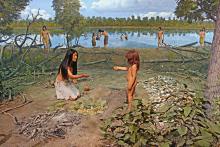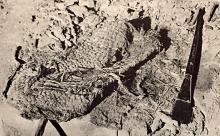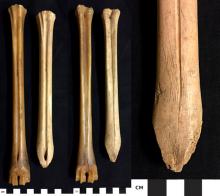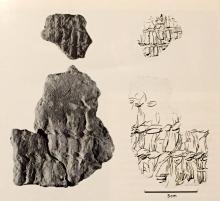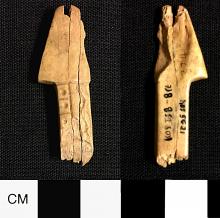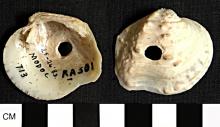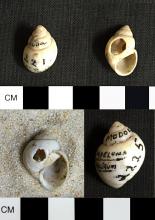We based the clothing shown in the Late Archaic Period diorama at the Illinois State Museum on preserved remains from Mammoth and Salts Cave in Kentucky and the dry shelters in the southern Missouri and northern Arkansas.
We are confident that Archaic Period Indians made clothing from skins and hides. Preservation of perishable materials rarely occurs at archaeological sites. The dry shelters in northwestern Arkansas and southern Missouri provide an exception to this rule. They included remains of clothing and ornaments made from perishable materials. Although these shelters include Archaic, Woodland, and Mississippian remains, they help us understand what we are missing at most open sites. Clothing preserved in the Arkansas dry shelters includes:
- a grass breechcloth from Bonebrake Bluff Rockshelter
- a deer skin moccasin with attached leggings from Bushwhack Bluff Rockshelter
- a woven sandal from Elk Spring Shelter and a woven shoe from Indian Bluff Rockshelter
- remnants of feather and fur robes from Blowing Spring Rockshelter
- a deer skin belt from Bonebrake Bluff Rockshelter
Archaeologists discovered a slipper made of woven plant fibers in Upper Salts Cave in Kentucky. It probably dates to the Early Woodland Period, which follows the Late Archaic Period. Image taken from Patty Jo Watson, 1969, The Prehistory of Salts Cave, Kentucky, Illinois State Museum Reports of Investigations, No. 16.
Archaeological remains from Mammoth Cave and Salts Cave in Kentucky also provide some evidence for clothing including sandals, but most of these remains date to the Early Woodland Period. Historic records provide rich evidence for use of animal parts for clothing and ornaments. We based the clothing in the Archaic Period diorama at the Illinois State Museum on remains recovered in Mammoth and Salts Cave and the dry shelters of Arkansas and Missouri.
Archaeologists recovered this beamer from a late Middle Archaic Period feature at the Koster site (left side of image). We included a left metatarsal from a modern deer in the comparative collection (right side of image) so you can see how the bone was modified to make the tool. The maker ground the metatarsal down and then ground the long edges of both sides of the tool to create very sharp edges. These edges are still sharp today. They used this tool to scrape hair from hides. Images taken by Bonnie Styles.
We rarely recover the perishable skins and hides at open sites, but we do find the bone and antler tools that were used to prepare them. In the Raw Materials and Tools section, we included images of gouges that were used to scrape and soften hides. We also showed an image of an antler handle that may have once held a scraper and served as a hide working tool. The tool shown in the image to the left is called a beamer. A beamer is a hide working tool that is used to remove the hair from the hide. It’s fascinating to think that around 5,700 RCYBP, a late Middle Archaic Period Indian probably used the beamer from the Koster site (image to left) to scrape the hair off a deer skin.
A late Middle Archaic person in a base camp at the Koster site made this tool from a deer metatarsal. People may have used it to stake down a hide or mat or perhaps a covering for a tent or lean-to. We compared both sides of the tool to a right deer metatarsal in the comparative collection so you can see how it was modified. We also provide a detail of the tip of this tool. Images taken by Bonnie Styles.
Archaeologists recovered the tool shown to the left at the Koster site. A late Middle Archaic Period person shaped the distal end of deer metatarsal to make a point. How do you think late Middle Archaic people might have used this tool? The shape of the tool and the polish on its end, suggest that it may have been used as a stake. The polish may have resulted from the tool being repeatedly pushed through hides or fabric into the ground. Perhaps this tool once held down a mat or the hide covering for a structure.
Archaeologists have also recovered bone needles from Archaic Period sites. People likely used the needles to sew clothing and other items. Archaeologists recovered bone needles from Middle Archaic deposits at the Black Earth site in southern Illinois. The needles had a drilled hole at the head for fine threads made from plant fibers, fur, or sinew. Archaeologists also recovered a Late Archaic drilled bone needle and possible needle tips at the Riverton Culture sites along the Wabash River in Illinois.
Archaeologists recovered these bone shuttles from the Riverton site in our study area. Late Archaic Period people used these shuttles to weave fabrics. Image taken from Howard D. Winters, 1969, The Riverton Culture, Illinois State Museum Reports of Investigations, No. 13.
Archaeologists have also recovered bone weaving tools (called shuttles) that were used to weave plant fibers into fabrics. They recovered Late Archaic perforated and unperforated flat shuttles and tubular shuttles with points at one or both ends from the Riverton Culture sites along the Wabash River.
This image shows mat impressions in fire-hardened sediment (left) and line drawings of positive clay impressions (right). Julianne Snider made the drawings from the clay impressions, and Marlin Roos took the photographs. Taken from Steven Ahler, 1991, Modoc Matting and Beads: Cultural Complexity in the Early Archaic Period, The Living Museum, Volume 53, No. 1, Illinois State Museum.
Impressions of twined fabrics or mats were discovered in late Early Archaic deposits at Modoc Rock Shelter (see image above). Archaic Period people made these fabrics between 8,100 and 8,000 RCYBP. They used a technique called spaced twining. They made the flat, vertical elements from cane or the inner bark of a tree. They used twisted cordage made from plant fibers to wrap the vertical elements at evenly spaced intervals. Impressions such as these are found in hardened sediments at other Archaic Period sites.
Archaic Period people made ornaments from bone, shell, and perishable materials. We know that feathers were used to decorate objects. The dry shelters in northwestern Arkansas included a remnant of a feather cloak from Blowing Spring Rockshelter and a stick with a feather affixed to the top from Bonebrake Bluff Rockshelter.
Archaeologists recovered these crutch-top pins from the Koster site. Late Middle Archaic Period people in the base camp may have worn these pins in their hair or on their clothes. The fronts and backs of both pins are shown. Images taken by Bonnie Styles.
Archaic Period people made numerous ornaments from bone and shell. They made distinctive bone pins during late Middle Archaic. They ground the pins into different shapes and polished them to a high gloss. We find these types of pins at Koster and Modoc Rock Shelter.
They sometimes engraved geometric designs on the pins. The designs include lines, dots, diamonds, and zig zags. Archaic Period people may have worn the pins in their hair and used them as pins on their clothing. We recovered similar forms of pins and types of designs at Modoc and Koster.
Dr. Richard Jeffries studied the distribution of these distinctive pins across the southern Midwestern United States to explore regional social interaction and integration in the late Middle Archaic. Dr. Jeffries observed that the shape of the pin and style of engraving “are culture-based decisions made by the manufacturer.” He chose to study the bone pins because these objects are relatively easy to modify and decorate. The patterning in forms and styles has great potential to yield social information about interactions among groups across a region.
Several archaeologists had argued that living in one place for a longer time in the late Middle Archaic base camps, created a need for greater social interaction and integration with other groups across a region. The development of more formal social networks with other groups would help keep interactions and information flow among groups that used to be maintained by seasonal movements of camps.
Jeffries discovered that the pins occur across a broad area of the southern Midwest. Archaeologists have recovered these kinds of pins at sites in the lower Illinois River valley (Koster site), middle Mississippi River valley (Modoc Rock Shelter), Missouri (Arnold Research Cave), and the Ohio River drainage including Southern Illinois (Black Earth site), Southern Indiana (Bluegrass site and McCain sites), and western Kentucky (KYANG site). Jeffries studied the pins from these 8 sites. He documented shared forms and designs. As several archaeologists had proposed, the shared forms and designs suggest some form of connectedness or interaction among people across this broad area.
Dr. Jeffries documented that each site had pins with multiple forms and styles. Rather than indicating exchange of pins among groups, he argues that this pattern suggests that the pins were locally made. The use of similar forms and designs indicates stronger social ties among groups. Because the pins are relatively common and occur in domestic contexts, he suggests it was the information carried by the form and design that was important not just the object. The form and designs on the pin relayed information on social relationships among groups.
This ornament made from a mapleleaf (Quardrula quadrula) freshwater mussel shell may have been worn as a pendant or adorned clothing. It has been drilled for suspension. An early Middle Archaic person living in the Modoc Main shelter ultimately lost or discarded it. Archaeologists recovered it in 1953. Images taken by Bonnie Styles.
At both Modoc and Koster, Archaic Period people drilled freshwater mussel shells to make pendants and beads for necklaces or for sewing on clothing. They also made tubular bone beads from mammal and bird bones. Archaic Period people incised designs on some of the late Middle Archaic bone beads at the Black Earth site. Archaic Period people also drilled the roots of mammal teeth to make pendants or beads.
These freshwater snail shells (Campeloma decisum) were possibly perforated to be worn as beads or pendants by the middle Middle Archaic Period people living in the Modoc Main Shelter. As an alternative, people may have made the holes to suck out the snails. Archaeologists recovered these shells in 1953. Both sides of each shell are shown. Images taken by Bonnie Styles.
Archaic Period people also made pendants and beads from freshwater gastropods (snails). They perforated large aquatic gastropod shells such as Campeloma decisum to serve as pendants or adornments for clothing. We recover middle Middle Archaic perforated Campeloma shells at Modoc Rock Shelter. These snails were locally available in the Mississippi River drainage.
These three beads are made from the main stream river snail (Leptoxis praerosa). They were recovered in early Middle Archaic Period deposits in the Modoc Main Shelter in 1984. We also found beads from this species in middle Middle Archaic deposits. Both sides of each shell are shown. Image taken by Doug Carr.
Smaller shells, such as those from the main stream river snail (Leptoxis praerosa, formerly called Anculosa) shells were ground and strung using either the natural interior structure of the shell or a drilled hole. We recovered beads made from these snails in the early and middle Middle Archaic deposits at Modoc Rock Shelter. Archaeologists recovered remains of belts and bracelets decorated with Leptoxis praerosa shell beads in the Archaic mortuary component at the Elizabeth site on the blufftop in the lower Illinois River valley. These remains maybe associated with the Middle Archaic occupations at the Napoleon Hollow site in our study, which lies below the Elizabeth site.
Today, this species of snail occurs in the Ohio River drainage from Cincinnati southward. Middle and Late Archaic Period sites in the Ohio River Drainage in Kentucky, including the Green River Shell Middens in our study area, contain numerous beads made from this snail species.
Did the Archaic Period inhabitants of Modoc Rock Shelter and Napoleon Hollow travel south—perhaps to Kentucky to collect these snails? Perhaps they received the snail shells or finished beads through trade from one camp to the next. Some archaeologists call this type of exchange down-the-line exchange. It does not require long distance travel. Another possibility is that the natural distribution of these shells was different during the Middle Archaic Period. These freshwater snails may have occurred in the Mississippi Drainage and may have been collected locally.
We are examining the occurrence of these types of shell ornaments across our study area to determine if they will reveal information on exchange and/or social networks.
Archaeologists recovered these marine gastropod (Marginella apicina) shell beads in early Middle Archaic deposits in the Modoc Main Shelter in 1984. We also found some in late Early Archaic deposits. The beads have been ground on the interior side. The first bead has a hole drilled in the body of the shell. Both sides of each bead are shown. Images taken by Doug Carr.
Archaic Period people also made shell beads from marine gastropod (snail) shells. In 1984, archaeologists recovered the shell beads from late Early Archaic and early Middle Archaic deposits in the Modoc Main Shelter. They are made from common Atlantic marginella (Marginella apicina) snail shells. These marine snail shells were originally collected along the Southern Atlantic or the Gulf Coast. Did some of the inhabitants of Modoc travel to the Southern Atlantic or Gulf coast to collect these snail shells? They may have received the shells or even the finished beads through exchange from one camp to the next. As noted above, such down-the-line exchange does not require long distance travel. The marine shell beads from Modoc represent some of the earliest examples of marine shell artifacts in the Midwestern United States. Given their rarity, they may have been important to the people at Modoc.
We are also exploring the distribution of these distinctive beads across our study area to see if they will reveal information on exchange and/or social networks.



